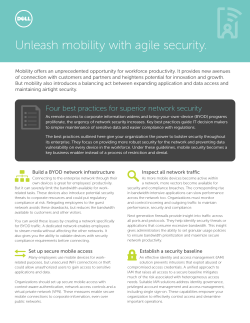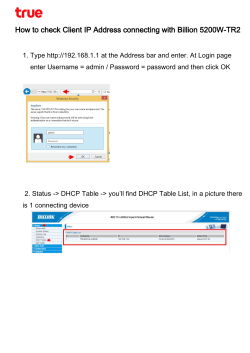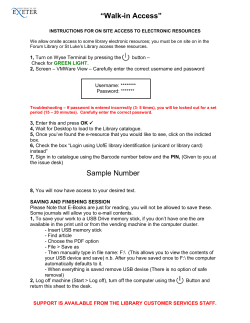
1 Building an Identity Management Business Case 2 Agenda 3
1 Building an Identity Management Business Case Managing the User Lifecycle Across On-Premises and Cloud-Hosted Applications Justifying investment in identity management automation. 2 Agenda • • • • • Business challenges due to managing identities, authentication factors and entitlements. Identity and access management (IAM) overview. IAM value proposition. Supporting metrics. Effective IAM projects. 3 Business Challenges © 2015 Hitachi ID Systems, Inc. All rights reserved. 1 Slide Presentation 3.1 The User Lifecycle At a high level, the user lifecycle is essentially the same in all organizations and across all platforms. 3.2 IAM in Silos In most organizations, many processes affect many applications. This many-to-many relationship creates complexity: © 2015 Hitachi ID Systems, Inc. All rights reserved. 2 Slide Presentation 3.3 Identity and Access Problems For users • • • • • For IT support How to request a change? Who must approve the change? When will the change be completed? Too many passwords. Too many login prompts. • Onboarding, deactivation across many apps is challenging. • More apps all the time! • What data is trustworthy and what is obsolete? • Not notified of new-hires/terminations on time. • Hard to interpret end user requests. • Who can request, who should authorize changes? • What entitlements are appropriate for each user? • The problems increase as scope grows from internal to external. 3.4 Identity and Access Problems (continued) For Security / risk / audit For Developers • Orphan, dormant accounts. • Too many people with privileged access. • Static admin, service passwords a security risk. • Weak password, password-reset processes. • Inappropriate, outdated entitlements. • Who owns ID X on system Y? • Who approved entitlement W on system Z? • Limited/unreliable audit logs in apps. • Need temporary access (e.g., prod migration). • Half the code in every new app is the same: – – – – – Identify. Authenticate. Authorize. Audit. Manage the above. • Mistakes in this infrastructure create security holes. © 2015 Hitachi ID Systems, Inc. All rights reserved. 3 Slide Presentation 3.5 Business Drivers for IAM Security / controls. • Reliable deactivation. • Strong authentication. • Appropriate security entitlements. Regulatory compliance. • PCI-DSS, SOX, HIPAA, EU Privacy Directive, etc. • Audit user access rights. IT support costs. • Help desk call volume. • Time/effort to manage access rights. Service / SLA. • Faster onboarding. • Simpler request / approvals process. • Reduce burden of too many login prompts and passwords. 3.6 IAM is Linked to Regulations • Many regulations, in many jurisdictions, call for internal controls: – This implies effective AAA: Authentication, Authorization and Audit. • Every system already has AAA. – The weakness is bad user/access data. • The missing link is business process: – Appropriate access rights. – Timely access termination. – Effective authentication. • Identity and access management process and technology are needed to bridge the gap between business requirements and AAA infrastructure. 4 IAM Overview © 2015 Hitachi ID Systems, Inc. All rights reserved. 4 Slide Presentation 4.1 Identity and access management Identity and access management is software to automate processes to securely and efficiently manage identities, entitlements and credentials: Processes: • • • • Policies: Data synchronization. Self-service requests. Authorization workflows. Manual and automated fulfillment. • • • • Connectors: Login ID assignment. Approvals workflow. Segregation of duties. Visibility, privacy. • • • • Applications. Databases. Operating systems. Directories. 4.2 Connecting Users to Applications Identity and access management can be thought of as middleware for pulling security administration out of application silos. Users Employees, contractors, customers, and partners Hitachi ID Suite Target Systems Business processes User Objects Related Objects Synchronization / Propagation Request / Authorization Delegated Administration Consolidated Reporting Attributes Passwords Privileges Home Directories Mail Boxes PKI Certs. 5 IAM Value Proposition © 2015 Hitachi ID Systems, Inc. All rights reserved. 5 Slide Presentation 5.1 IAM Benefits Identity and access management systems help organizations lower IT operating cost, improve user productivity and strengthen security: Security / compliance: IT cost: • Reliable, prompt and comprehensive deactivation. • Policy enforcement: segregation of duties, role-based access. • Simplify entitlement audit and cleanup. • Consistently strong authentication. User service: • Reduce help desk, security admin workload and head count. • Simplify, streamline audits. • Simplify change management. • Improve SLA – new hire, new access. • Fewer passwords to remember, enter. 5.2 Building a Business Case An investment in identity and access management processes and infrastructure is normally supported by cost savings, improved productivity and stronger security: Cost savings Productivity Security Reassign staff out of the help desk or user administration group. Help new users start work sooner and eliminate delays experienced by users who have problems or need changes. Clean up entitlements, enforce security policies and create audit logs. Comply with SOX, GLB, HIPAA, etc. Any business case should be supported by metrics: • Current state. • Desired outcome. 6 Supporting Metrics © 2015 Hitachi ID Systems, Inc. All rights reserved. 6 Slide Presentation 6.1 Metrics: Password Management Cost savings • Number of password problem help desk calls per month? • Cost and duration of each call? • Peak staffing to support post-weekend call volumes? Productivity • Time spent by users before, during and after a typical password problem? • Value of wasted user time? Security • How does the help desk authenticate callers? • Current vs. desired password policy on sensitive systems? • Popularity of password "sticky notes?" Example targets: • Reduce password help desk calls by 75%. • Reduce total help desk calls by 25%. • Reduce passwords per user to 2. 6.2 Metrics: IAM Cost savings • Number of user add / change / deactivate operations per month? • Cost and duration of each operation? • Number of access security admin staff? Productivity • Number of different forms used to request new / changed access? • Average time spent by users making requests (find the form, fill it out, send it to the right people, etc.)? • IT SLA to fulfill valid, authorized requests? Security • SLA to terminate access for ex-employees? Ex-contractors? Example targets: • Reduce onboarding time from 3 days to 3 hours. • Reduce admin FTEs from 6 to 2. • Terminate access within 1 hour of departure. © 2015 Hitachi ID Systems, Inc. All rights reserved. 7 Slide Presentation 6.3 Metrics: Access Certification Cost savings Security • Cost of user access audits? • Cost of excess software licenses? • Number of login accounts vs. number of real users? • Security or regulatory exposure due to inappropriate entitlements? • Total number of entitlements on integrated systems. • Average number of entitlements per user. 6.4 Metrics: Privileged Access Management Cost savings Productivity • Person days to change passwords on all privileged accounts. • Annual cost for production migrations because developers cannot be granted temporary access. • Number of admin password changes per month. • Number of emergency admin access events per month. Security • Number of privileged accounts per platform and total. • Number of systems per shared privileged account. • Time to deactivate terminated system administrators. • Time to determine what systems a departed administrator accessed before leaving. Example targets: • Time to deactivate administrator: 5 minutes. • All admin passwords changed daily. 7 Effective IAM Projects © 2015 Hitachi ID Systems, Inc. All rights reserved. 8 Slide Presentation 7.1 IAM Project Cost License and maintenance for components: • Directory. • Meta-directory. • Identity administration and access governance. • Password management. • Web, enterprise single signon (SSO). • Discovery, design. • Installation, configuration. • Testing, troubleshooting, user acceptance, pilot. • User rollout. • Incentives, user education and awareness. Servers • • • • Implementation services: Ongoing costs: Hardware. Operating system license. Rack space. Support services. • • • • System health monitoring. Adding features, integrations. User education, awareness. Ownership and coordination. 7.2 Minimizing Deployment Cost License model • Simple $/user includes: • All features: – Requests. – Approvals. – Automation. – Certification. – Password/PIN mgmt. – Reports. • All connectors. • Unlimited servers. Included tech. Time savers • Auto-discovery. • DB replication. • Multi-master, active-active. • 110+ connectors. • Manual fulfillment. • Proxy server. • Included web portal, request forms. • Reference implementation. • Policy-driven workflow. • Self-service ID mapping. Efficient platform • Native code (EXE). • Stored procs. • No J2EE or Sharepoint app server. • No separate products for workflow, reports, analytics, governance. • Works with existing directory. © 2015 Hitachi ID Systems, Inc. All rights reserved. 9 Slide Presentation 7.3 Change Management: The Human Factor • Identity and access management can be political: – There are many stake-holders: application owners, security administrators, the help desk, audit, network operations, etc. – It’s hard to get groups of people to agree on anything. – Executive sponsorship is essential to drive consensus. • The user community must be involved: – – – – Needs analysis. Usability. User training and awareness. Incentives and dis-incentives. • This is more about business process than technology: – How does your organization onboard new hires? manage change? terminate? – Business logic must capture authorization, login ID allocation, etc. 7.4 Getting an IAM Project Started • • • • Build a business case. Get management sponsorship and a budget. Discovery phase, capture detailed requirements. Assemble a project team: – – – – security system administration user support etc. • Try before you buy: Demos, POCs, pilots. • Install the software, roll to production. • Enroll users, if/as required. 500, 1401 - 1 Street SE, Calgary AB Canada T2G 2J3 Tel: 1.403.233.0740 Fax: 1.403.233.0725 E-Mail: sales@Hitachi-ID.com www.Hitachi-ID.com Date: May 14, 2015 File: PRCS:pres
© Copyright 2025












